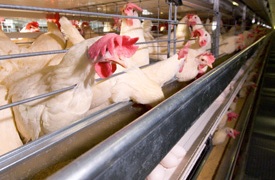Germany feels impact of cage ban

The German industry delayed converting its systems in preparations for the new legislation governing the use of cages in advance of an EU-wide ban in 2012. As a result, many have been caught out, and consequently been forced out of production, said Klaus Torborg of Lohmann Animal Health.
The number of layers dropped from 40 mln to around 33 mln, and self-sufficiency in eggs fell from 70% to 55%. Imports have flooded in from other countries, particularly Holland, which has been quicker to convert its systems, he continued.
In a scenario uncannily similar to the Edwina Currie disaster in 1988, a decade later the coalition German government, particularly influenced by Green Party Minister Renate Künast, sealed the fate of the German egg industry.
Under a ‘red/green’ government, Germany was over-eager in complying with EU policy and required enriched cages to be installed three years before it became necessary under EU law. But when the government changed to a conservative administration this was not repealed so the efforts of producers who had installed enriched cages were not rewarded. Their eggs were simply labelled as ‘Class 3’, the same as those from standard cages, explained Torborg.
Producers have, therefore, been faced with large-scale investment, but because of high level of demand, getting the equipment supplied in the time available has been more of an issue than simply price or even preferred choice.
A further big influence on the industry has been what the Germans term the ‘discounters’ – supermarkets such as Aldi, Lidl and Netto. “The discounters now account for around 47% of all eggs sold in Germany and, for marketing/animal welfare reasons, will not sell eggs from enriched cages. Therefore, most egg producers, despite high investment in enriched cages, will have to convert to the barn system,” he said.
Cage houses converted to the barn system hold far fewer birds, due to the lower stocking density, so many producers are, additionally, faced with putting up new buildings if they wish to maintain their hen numbers.
Torborg suggested investment costs for converting to a barn system in Germany would be €20-22 (£18-£20) per bird place, €28-32 (£25-£28) if putting up a new building; €18-22 (£16-£20) for enriched cages and €15-20 (£13-£18) for free-range and organic. Costs of production, per egg, would be increased by 1 cent for enriched cages, 2.4 cents for a barn system and 3.5 cents for free-range (10.7p, 25.7p and 29.6p per dozen, respectively) compared with cages.
Next year it is anticipated that 60%p of eggs will be produced in barn systems, 20% in enriched cages and 20% from free-range and organic, explained Torborg.
German egg consumption is healthy with the 80 mln human population consuming an average of 207 eggs per head per year – compared with 172 in Britain – but the discounters are likely to put increasing pressure on prices, he pointed out.
Currently, one discounter sells barn and free-range eggs for €1.29 and €1.59 (£1.15 and £1.42) per 10, respectively. In general, producer price levels are reasonable and Torborg was optimistic that if there are no big changes Germany should get back to 40 mln layers by 2012.













